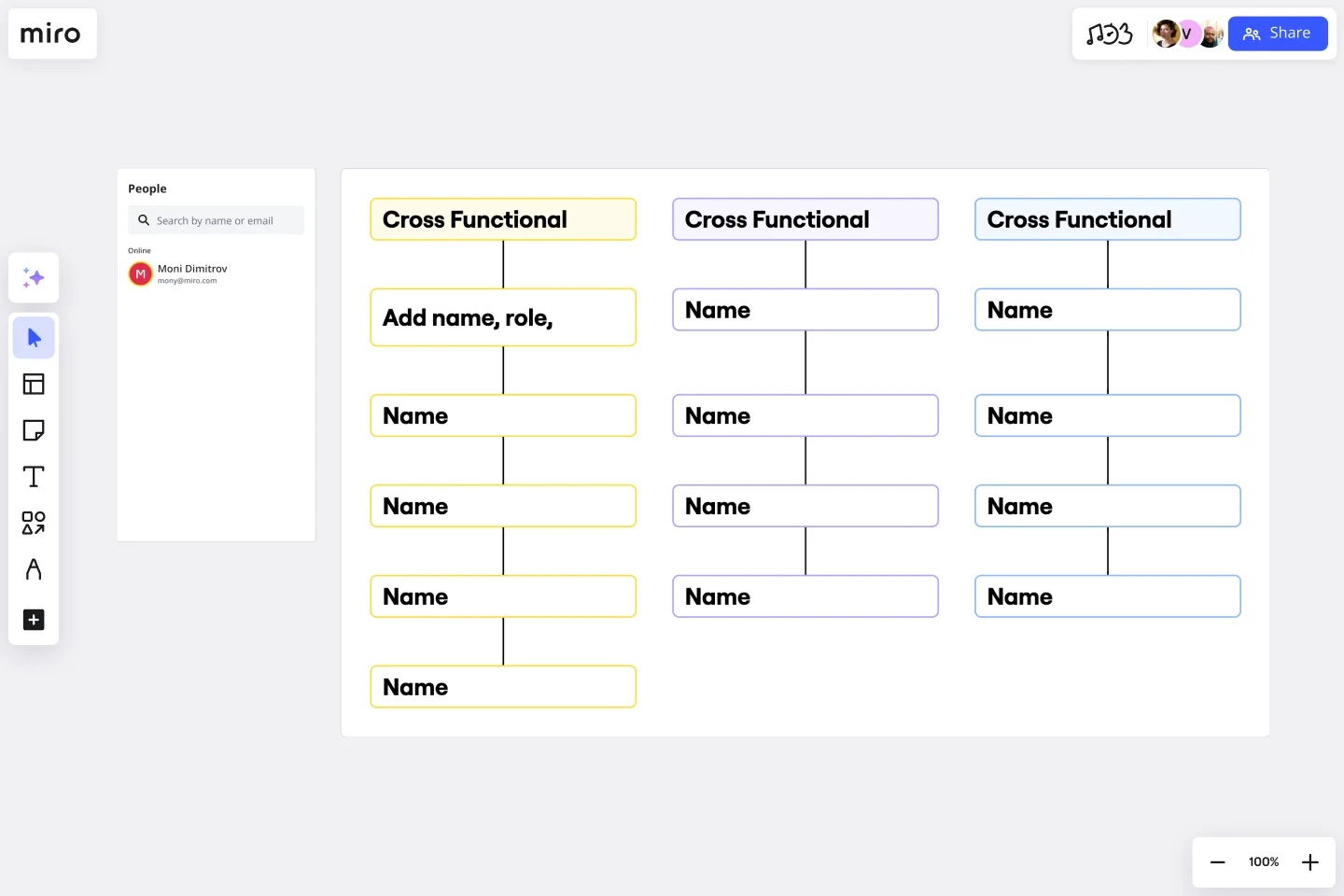Team (XFN) Chart Template
Illustrate the structure of three cross-functional teams within an organization with the team (XFN) chart template.
About the Team (XFN) Chart Template
The Team (XFN) Chart Template is a tool designed to enhance visibility and streamline the planning and execution processes within cross-functional teams. This template allows for a comprehensive view of team structures, responsibilities, and interdependencies, making it easier to identify each team member's roles and contributions. By using this template, teams can foster a more collaborative environment, ensuring that everyone is aligned with the project's goals and timelines.
How to use the team (XFN) chart template
Start with the basics: Outline your team's core structure. Use the template to map out your project's different roles and departments.
Define relationships and dependencies: Use the chart to illustrate the relationships between different team members and departments. Highlight any dependencies that might impact project execution, ensuring clarity on who relies on whom for information, resources, or decision-making.
Customize for clarity: The template is designed to be flexible. Add additional layers of information, such as project timelines, specific tasks, or key milestones, to provide a comprehensive overview of the project's scope and responsibilities.
Iterate and update: As projects evolve, so do team dynamics and requirements. Regularly revisit and update the team (XFN) chart to reflect any changes, ensuring that the chart remains a reliable source of truth for the entire team.
Why use a team (XFN) chart template
Maintaining clarity and alignment within cross-functional teams is more important than ever in today's fast-paced and interconnected work environments. The team (XFN) chart template serves as a foundational tool for achieving these objectives, offering several key benefits:
Enhanced visibility: The team (XFN) chart provides a bird's-eye view of the entire project team, making it easier to understand how different parts of the team fit together and contribute to the project's success.
Improved collaboration: By clearly defining roles, responsibilities, and dependencies, the chart encourages open communication and collaboration among team members, helping to break down silos and foster a more inclusive working environment.
Streamlined planning and execution: With a clear understanding of the team's structure and interdependencies, planning and execution become more efficient. Teams can anticipate potential bottlenecks or conflicts and address them proactively, leading to smoother project delivery.
Adaptability: The team (XFN) chart is adaptable to various project sizes and complexities. Whether you're working on a small initiative or a large-scale project, the chart can be customized to meet your team's specific needs.
Get started with this template right now.
Collaboration Cosmos Team Charter
Works best for:
Org Charts, Operations, Mapping
The Collaboration Cosmos Team Charter template fosters collaboration by defining team goals and values. By visualizing team dynamics and norms, this template aligns team members and promotes mutual understanding. With sections for setting collaboration guidelines and documenting team agreements, this template enhances communication and teamwork, enabling teams to achieve shared objectives effectively.
Project Organizational Chart Template
Works best for:
Project Management, Documentation, Org Charts
When you’re embarking on a long, complex project, you will inevitably hit roadblocks and obstacles. It’s important to have your project organizational chart on hand to overcome those challenges. A project organizational chart is a visual diagram that illustrates who is on your team and the role they play in a given project. It documents the structure of the project organization, the hierarchy between team members, and the relationships between employees. Project organizational charts are useful tools for clarifying who does what, securing buy-in, and setting expectations for the group.
Cross Disciplinary Org Structure
Works best for:
Org Charts, Operations, Mapping
This template is for cross-disciplinary, distributed teams to show how teams are made up.
Partnership Org Chart Template
Works best for:
Org Charts, Organizational Design
The Partnership Org Chart Template is an interactive tool that visually represents the intricate network of relationships between business partners. It provides a clear and structured layout that helps users grasp how different entities align and interact within a collaborative ecosystem. One of its standout benefits is the clarity it offers. In the often complex world of inter-organizational relationships, having a straightforward, visual representation of partnerships eliminates ambiguities and ensures all stakeholders are on the same page. This fosters more effective collaboration and strategic planning, making it an essential business tool.
Partnership Org Chart Template
Works best for:
Org Charts, Organizational Design
The Partnership Org Chart Template is an interactive tool that visually represents the intricate network of relationships between business partners. It provides a clear and structured layout that helps users grasp how different entities align and interact within a collaborative ecosystem. One of its standout benefits is the clarity it offers. In the often complex world of inter-organizational relationships, having a straightforward, visual representation of partnerships eliminates ambiguities and ensures all stakeholders are on the same page. This fosters more effective collaboration and strategic planning, making it an essential business tool.
Inverted Org Chart Template
Works best for:
Org Charts, Organizational Design
The Inverted Org Chart Template is a tool that reimagines the traditional hierarchical model by placing frontline employees at the top of the organizational structure. This innovative approach highlights the crucial role played by those who interact with customers directly, ensuring that their insights and contributions are not only recognized but also celebrated. One of the key advantages of this template is that it fosters a feedback-driven environment. Prioritizing frontline workers promotes a culture where valuable insights from the ground can quickly reach the top of the hierarchy, streamlining decision-making processes and ensuring that strategies are based on real-world experiences.

